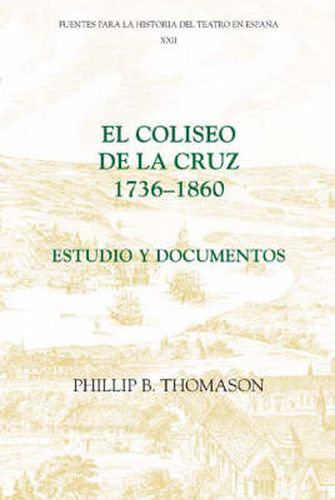Readings Newsletter
Become a Readings Member to make your shopping experience even easier.
Sign in or sign up for free!
You’re not far away from qualifying for FREE standard shipping within Australia
You’ve qualified for FREE standard shipping within Australia
The cart is loading…






The Coliseo de la Cruz, the first modern public theatre in Madrid, was constructed (1736-37) on the site of the city’s oldest permanent playhouse, the Corral de la Cruz, dating from 1579. The corral, an open-air courtyard theatre, was surrounded by private boxes in neighbouring houses (recently studied in this series by Charles Davis), which only intermittently contributed to the municipal coffers; by 1736, moreover, it was decrepit and ill-suited to current staging requirements. The city authorities therefore replaced it by an up-to-date, fully self-contained theatre building with a proscenium stage. The new coliseo was fashioned in the Italian style, but maintained many characteristics of the corral theatres, such as the cazuela (separate women’s gallery), and continued to attract a varied audience, representing virtually every level of Madrid society. Finally, in 1859, the Coliseo de la Cruz, by now inadequate and in ill repair, was demolished to alleviate traffic congestion at the Puerta del Sol. PHILLIP B.THOMASON is Professor of Spanish at Pepperdine University, California. El Coliseo de la Cruz, el primer teatro publico moderno de Madrid, fue construido (1736-37) en el solar del corral de comedias mas antiguo de la ciudad, el Corral de la Cruz, inaugurado ya en 1579. El corral, con su patio al aire libre, habia estado rodeado de aposentos particulares situados en las casas colindantes (estudiados recientemente en esta serie por Charles Davis), cuyos duenos contribuian relativamente poco a los fondos municipales; en 1736, ademas, estaba deteriorado y poco adecuado para la nueva escenografia. Por tanto, el Ayuntamiento lo derribo, reemplazandolo por un teatro moderno, enteramente cubierto, con proscenio y decorados en perspectiva. El nuevo coliseo estaba disenado al estilo italiano, pero retenia muchos elementos de los corrales de comedias, entre ellos la cazuela de las mugeres, y siguio atrayendo a un publico variado, que incluia practicamente todos los estratos de la sociedad madrilena. Finalmente, en 1859, el Coliseo de la Cruz, ya desfasado y deteriorado a su vez, fue derribado para aliviar los problemas de trafico en la Puerta del Sol. PHILLIP B.THOMASON es profesor de espanol de Pepperdine University, California.
$9.00 standard shipping within Australia
FREE standard shipping within Australia for orders over $100.00
Express & International shipping calculated at checkout
The Coliseo de la Cruz, the first modern public theatre in Madrid, was constructed (1736-37) on the site of the city’s oldest permanent playhouse, the Corral de la Cruz, dating from 1579. The corral, an open-air courtyard theatre, was surrounded by private boxes in neighbouring houses (recently studied in this series by Charles Davis), which only intermittently contributed to the municipal coffers; by 1736, moreover, it was decrepit and ill-suited to current staging requirements. The city authorities therefore replaced it by an up-to-date, fully self-contained theatre building with a proscenium stage. The new coliseo was fashioned in the Italian style, but maintained many characteristics of the corral theatres, such as the cazuela (separate women’s gallery), and continued to attract a varied audience, representing virtually every level of Madrid society. Finally, in 1859, the Coliseo de la Cruz, by now inadequate and in ill repair, was demolished to alleviate traffic congestion at the Puerta del Sol. PHILLIP B.THOMASON is Professor of Spanish at Pepperdine University, California. El Coliseo de la Cruz, el primer teatro publico moderno de Madrid, fue construido (1736-37) en el solar del corral de comedias mas antiguo de la ciudad, el Corral de la Cruz, inaugurado ya en 1579. El corral, con su patio al aire libre, habia estado rodeado de aposentos particulares situados en las casas colindantes (estudiados recientemente en esta serie por Charles Davis), cuyos duenos contribuian relativamente poco a los fondos municipales; en 1736, ademas, estaba deteriorado y poco adecuado para la nueva escenografia. Por tanto, el Ayuntamiento lo derribo, reemplazandolo por un teatro moderno, enteramente cubierto, con proscenio y decorados en perspectiva. El nuevo coliseo estaba disenado al estilo italiano, pero retenia muchos elementos de los corrales de comedias, entre ellos la cazuela de las mugeres, y siguio atrayendo a un publico variado, que incluia practicamente todos los estratos de la sociedad madrilena. Finalmente, en 1859, el Coliseo de la Cruz, ya desfasado y deteriorado a su vez, fue derribado para aliviar los problemas de trafico en la Puerta del Sol. PHILLIP B.THOMASON es profesor de espanol de Pepperdine University, California.